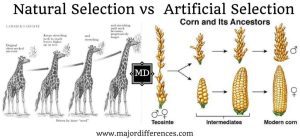Unit 7.3: Artificial Selection in AP Biology
Mechanisms of Evolution
Natural selection and artificial selection are two key mechanisms that drive evolution. Both processes lead to changes in the genetic makeup of populations over time, but they operate in different ways and under different influences.
We know that natural selection is a process in which heritable variations in traits lead to differential reproductive success. Organisms with traits that provide an advantage are more likely to survive, reproduce, and pass on their genes to their offspring. This results in gradual changes in allele frequencies in a population, which can lead to adaptation and even the evolution of new species over time.
In contrast, artificial selection is a type of selective breeding where humans actively choose which individuals will reproduce based on desirable traits. Unlike natural selection, which is driven by selective pressures from the environment, artificial selection is guided by human preferences. This deliberate selection can result in rapid changes in the phenotypic makeup of a population, giving rise to new varieties of plants and animals that exhibit traits deemed beneficial or attractive by humans.
Phenotypic Variety and Artificial Selection
Artificial selection has been used for thousands of years to breed plants and animals with specific traits. For example, farmers have selectively bred dairy cows to increase milk production, while horticulturists have cultivated crops to enhance pest resistance or improve nutritional value. In artificial selection, humans determine which traits are favorable, rather than those traits being shaped by natural environmental pressures.
A classic example of artificial selection is seen in dog breeding. Domestic dogs are the result of centuries of selective breeding to enhance desirable characteristics, such as loyalty, herding ability, or specific physical features. This human intervention has led to a tremendous diversity of dog breeds, each with its unique set of traits.
Artificial selection is not only applied for practical purposes but also serves as a valuable tool for understanding the genetics behind traits. By intentionally breeding organisms for specific characteristics and tracking the inheritance of these traits over multiple generations, scientists can gain valuable insights into the genetic basis of those traits. This helps us understand how traits are passed from one generation to the next and how different genes interact to produce unique phenotypes.
Convergent Evolution and Environmental Pressures
Environmental pressures also play a crucial role in shaping traits, but in a more natural context. Convergent evolution is a phenomenon where unrelated or distantly related organisms evolve similar traits independently, due to facing similar environmental pressures. This means that, even though the organisms are not closely related, they evolve to look or function in similar ways because they have adapted to similar environments and challenges.
A great example of convergent evolution can be seen in the wings of birds, bats, and insects. Despite the fact that birds, bats, and insects evolved wings independently and do not share a recent common ancestor, their wings are similar in structure and function. The wings of birds and bats, for example, have thin, flexible structures composed of bones and skin that allow for dynamic movement through the air. This similarity in structure and function is due to convergent evolution—all these organisms evolved wings as an adaptation to the selective pressures of flight.
While convergent evolution isn’t directly related to artificial selection, it’s another example of how environmental pressures—both natural and artificial—can shape the evolution of organisms and drive similar adaptations in unrelated species.
Key Points of Artificial Selection
Artificial selection is the intentional breeding of organisms to bring out desirable traits.
Humans have used artificial selection for thousands of years to improve crops, animals, and other living organisms.
Unlike natural selection, artificial selection is guided by human preference rather than natural environmental pressures.
The process allows scientists to better understand the genetics behind specific traits and their inheritance.
Artificial selection showcases the power humans have to shape genetic outcomes, allowing us to cultivate new varieties of plants and animals to meet our needs and desires. It is also a powerful tool for studying genetics and deepening our understanding of evolution.










